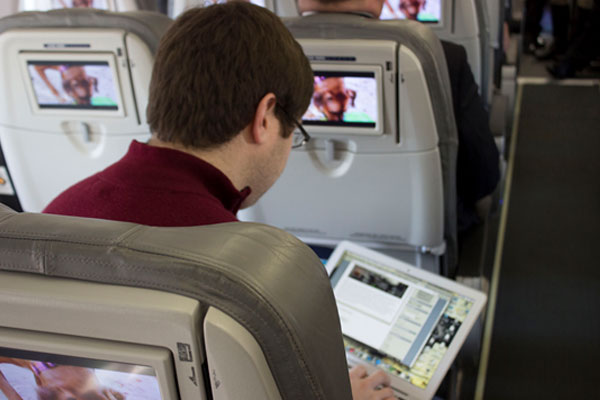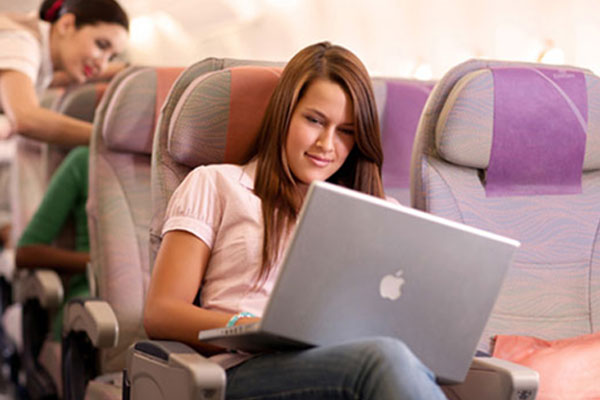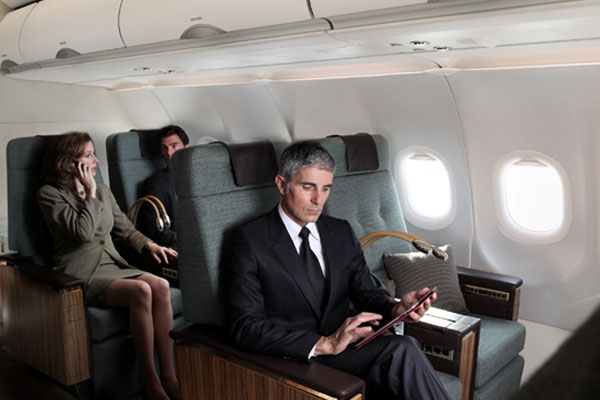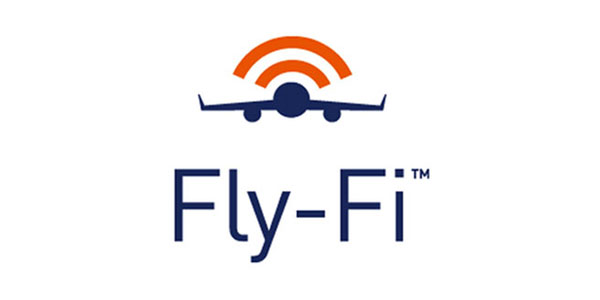
Having access to the Internet while onboard is becoming a key differentiator for a number of travellers when choosing which airline to fly with. In fact, for some, it is fast becoming essential. However, while there can be no mistaking what passengers want, satisfying their demands is not an easy task. Limited bandwidth and slow connection speeds are often cited as the downside of existing solutions, but as for making high-quality in-flight Wi-Fi the norm, rather than a luxury, the day-to-day operating costs are just as big a hurdle.
In short, airlines want to offer the best possible connectivity service to stand out from the crowd, passengers want a fast Wi-Fi connection to avoid being cut off from their lives on the ground, and, naturally, suppliers want every airline to embrace in-flight Wi-Fi for obvious business reasons. But who should foot the bill?
Passengers: We want Wi-Fi, but we want it for free
A recent survey by Honeywell Aerospace found that 90% of passengers value in-flight Wi-Fi so highly that they would give up another amenity, such as some of their legroom or a good food and beverage service, to guarantee a reliable Wi-Fi connection. On the other hand, though, a 2013 report carried out by Holiday Extras found that 84% of the 4,000 flyers that took part in a survey stated that they would rather have no access to Wi-Fi rather than pay more for the service.
Figures from in-flight connectivity provider Gogo seem to back up the latter study, stating that uptake for its paid-for onboard Wi-Fi service remains below 6%. It seems passengers want in-flight Wi-Fi, but they don’t want to pay for it. So, does that mean the airlines and suppliers should be the ones funding it?
Airlines: We need to simplify connectivity pricing models

In some instances, airlines are subsidising the service, appreciating the fact that paying the bill is a short-term hit worth taking in order to meet the demands of their passengers. One such airline is Emirates, which heavily subsidises the connectivity offered on its A380s and B777s. However, such subsidies are not planned to last forever and in a recent interview with FTE, Patrick Brannelly, Emirates’ Vice President, Product, Publishing, Digital and Events, explained that airlines are not too keen on funding the service in the long-term because of the confusion around existing pricing models.
“You can almost guarantee in the future this ‘cost per megabyte’ model is going to go away because nobody understands it,” he stated. It’s hardly surprising that an airline might not be eager to continually fund something when they are unsure exactly how much it will, or should, cost. However, if Emirates, and all other airlines in similar positions, don’t subsidise the service, who will pay the difference? We already know that most passengers don’t want to pay, so that leaves the suppliers.
Suppliers: Funding Wi-Fi is the airlines’ responsibility

While subsidising the service to help gain early market share has been a prevalent practice in this sector, the suppliers have no intentions to continue to do this in long run. In fact, according to OnAir, another in-flight connectivity provider, airlines should be funding the hardware and then looking to use their Wi-Fi product more widely to get better value from it.
According to François Rodriguez, Director – Marketing, OnAir, funding must be tailored to each airlines’ strategy. “It is important to also recognise that airlines derive significant operational benefits by having an aircraft connected, so clearly that needs to be taken into account,” he said. These operational benefits include things such as providing real-time monitoring of the aircraft. Looking further ahead, Rodriguez added: “The proliferation of the connected aircraft, with airlines using connectivity to make operational savings, could well lead to more airlines offering Wi-Fi free of charge in the future.” In essence, free high-quality Wi-Fi could be on the way, but we must wait for the airlines to make Wi-Fi more widely available and learn how to use it for their own operational benefit.
So, this is where we stand: passengers don’t want to pay for high-quality Wi-Fi, suppliers want the airlines to pay for hardware but remain removed from the debate surrounding the day-to-day running costs, but airlines claim to not understand the pricing models.
JetBlue decides to go it alone

JetBlue, meanwhile, shouldn’t have the problem of not understanding the day-to-day running costs for providing onboard Wi-Fi. After all, last December, the airline launched its own ‘Fly-Fi’ connectivity service, which it developed alongside its wholly owned subsidiary, LiveTV, and ViaSat. The basic service is available for free until June 2014, with a higher-speed connection available at a premium.
“Once the iPhone came along, we realised that neither Beta Blue (JetBlue’s original Wi-Fi service) nor any of the other solutions which were becoming available could hope to support that level of data consumption,” explained Jamie Perry, Director of Product Development, JetBlue. “When we looked around at the options in 2008, we didn’t think any of the solutions that were coming online at the time would provide the speed, the capacity or the economics that were going to be needed.” Hence the development of the ‘Fly-Fi’ Ka-band service, which Perry explained “provides far higher capacity than the Ku-band or ATG solutions that exist today, at far better economics”.
So, do these “far better economics” mean the service could become complimentary in the long-term? “We have committed to a free Fly-Fi product through the end of June 2014,” Perry continued. “We are still reviewing our options after that, but we hope to maintain an element of free service beyond June.”
Maintaining some form of free service is great news for the consumer, but ultimately, reliable, high-speed Wi-Fi will remain a paid-for service. So, it’s back to the passengers to fund in-flight connectivity, even though they don’t seem very keen to do so.
Global connectivity at a lower cost
Another company that is promising to make a difference to the in-flight connectivity market is Inmarsat. It launched the first of its Global Xpress (GX) satellites in December, which, it says, is a vital step towards bringing office- and home-like in-flight connectivity to fruition across the world. While we’ll have to wait and see who will fund this high-quality Wi-Fi, Inmarsat is confident that it addresses all of the current concerns.
“GX Aviation is taking the next step forward in terms of technology, but also in terms of capacity, which means we can offer higher capacity, higher speed, higher performance capability onboard the aircraft, but at more affordable costs,” explained Miranda Mills, President of Inmarsat Aviation. “That’s something that’s of primary importance to us, especially in the commercial air transport market where we know that passengers and airlines are very price sensitive.”
So, while the buck will more than likely continue to be passed in the debate regarding who should fund this high-quality in-flight Wi-Fi that everyone seems to want, it will be interesting to see if the airlines, passengers or suppliers – or a combination of all – take responsibility for footing this “more affordable” bill. Here at FTE, we expect the debate to rumble on for a long time yet.






